Driving Test
1/215
Earn XP
Description and Tags
California DMV Test
Name | Mastery | Learn | Test | Matching | Spaced |
|---|
No study sessions yet.
216 Terms
Headsets and earplugs…
Are illegal to wear while driving
The three types of steering
Hand-to-Hand Steering (Push/Pull)
Hand-Over-Hand Steering
One-Hand Steering
Hand-to-Hand Steering (Push/Pull)
To use this steering wheel method…
Hands at 9 and 3 o’clock or 8 and 4 o’clock
Do not cross your hands over the wheel
Keep hands in these positions even while making turns
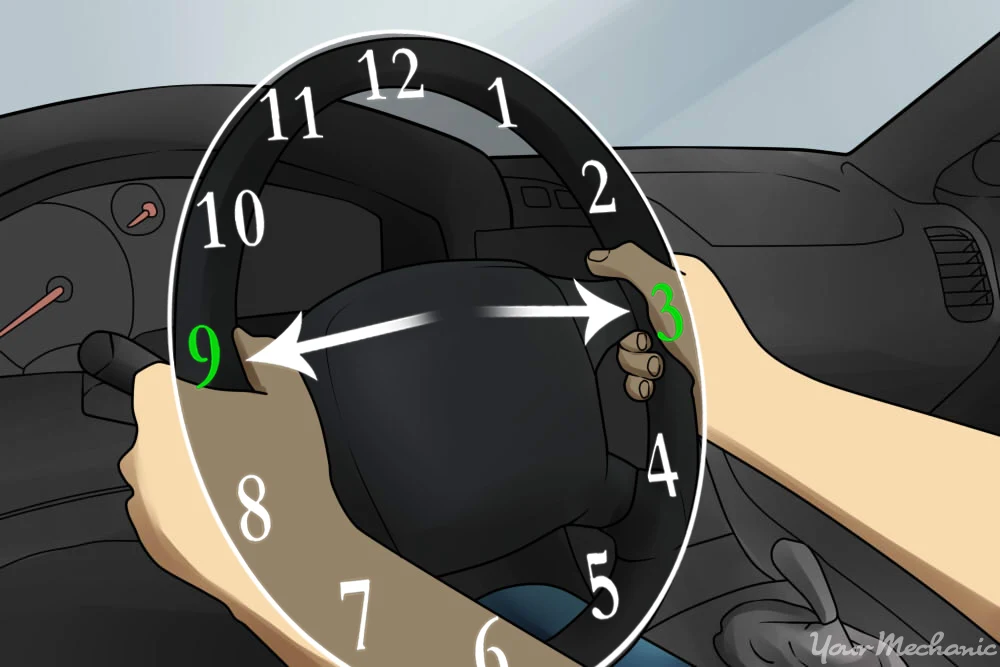
One-Hand Steering
Use when…
Turning while backing up, place your hand at 12 o’clock
Operating vehicle controls that require you to remove a hand from the steering wheel
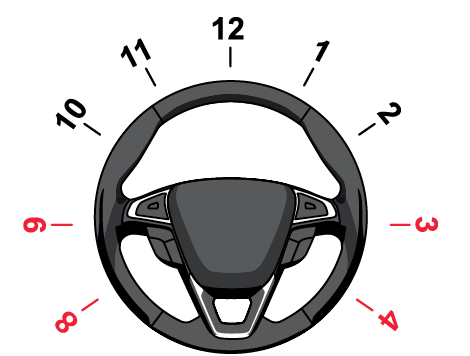
Hand signaling when…
Hand signal when…
Your signal lights are not working
Bright lights make your signal lights hard to see

You should signal…
100+ ft before a turn
Before every lane change
5+ seconds before you change lanes on a freeway
Before pulling next to or away from a curb
Remember to turn off your signal when you no longer need it!
You should signal even when…
You do not see other vehicles around you
You are almost through an intersection and plan to turn shortly after you cross it
Use your horn to…
Avoid collisions
Alert oncoming traffic on narrow mountains where you can’t see 200+ ft ahead
Dim your high-beam headlights to low beams when…
You are within 500 ft of a vehicle coming toward you or 300 ft of a vehicle you are following
It is illegal to drive using only…
Parking lights
Use headlights when…
In relation to the sun…
It is too dark to see from 1,000 ft away
30 mins after sunset until 30 mins before sunrise
In relation to weather…
In adverse weather (if you need to use windshield wipers due to fog, rain, or snow, turn on your low-beam headlights)
When conditions (e.g. clouds, dust, smoke, fog) prevent you from seeing other vehicles
In relation to road information…
On mountain roads and tunnels (even on sunny days)
When road signs state headlights must be on
Overall purpose:
To help other drivers see your vehicle, especially when the sun is low
To help yourself see
If you see a collision or hazard ahead, warn drivers behind you by…
Turning on your emergency flashes
Lightly taping your brake pedal 3-4 times
Use a hand signal when slowing or stopping
If you need to stop because of vehicle trouble…
Turn on emergency flashes (if your vehicle doesn’t have them, use your turn signals)
Pull off the road and away from traffic
If you cannot get off the road, stop where people can see you and your vehicle
DO NOT stop on a hill or just around a curve
Call for emergency roadside assistance (stay by your vehicle until help arrives)
When should you use emergency flashes?
To warn other drivers if you see a collision or hazard ahead
If you need to stop because of vehicle trouble
What are traffic lanes?
A section of the road for a single line of traffic
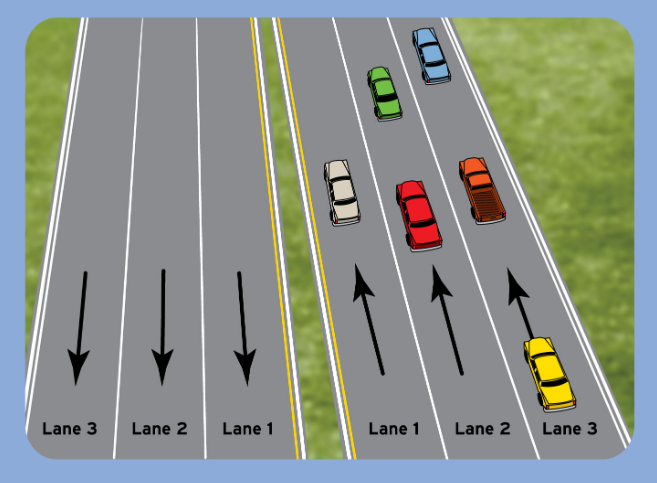
What are lane markings?
Road surfaces that help drivers know which part of the road to use and understand traffic rules
E.g. single solid yellow line, broken yellow line, end of lane markings, yield line
Single solid yellow line
Two-way traffic
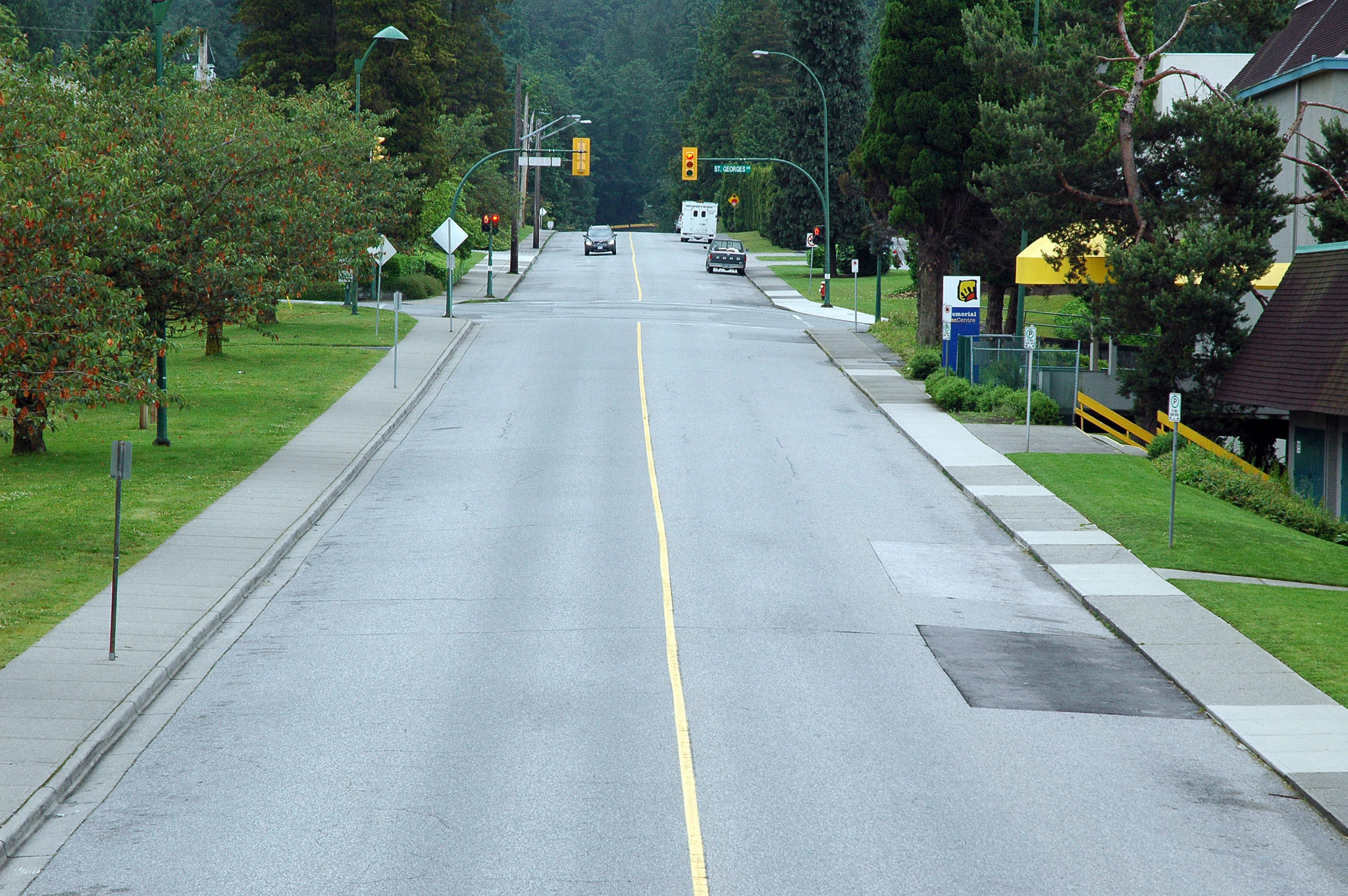
Double solid yellow line
Do not pass over these lines! Always stay to the right unless…
In a high-occupancy vehicle carpool lane with a designated entrance on the left
Instructed by construction or other signs because your side of the road is closed or blocked
Turning left across a single set of double yellow lines to enter or exit a driveway or private road or make a U-turn
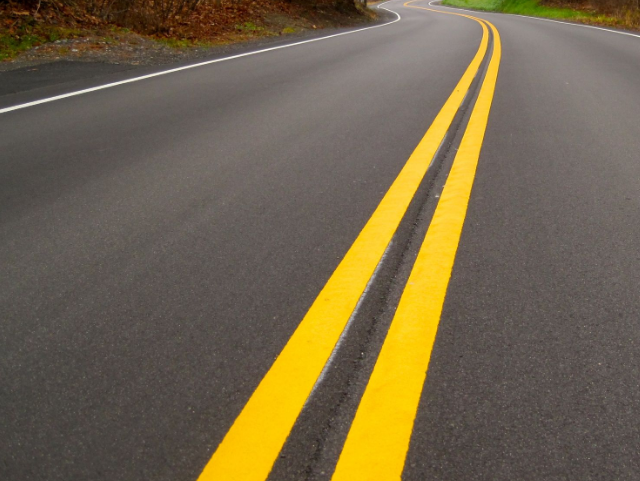
Two sets of solid double yellow lines spaced two or more feet apart
Considered a barrier
Do not drive over this barrier, make a left turn, or a U-turn expect at designated openings
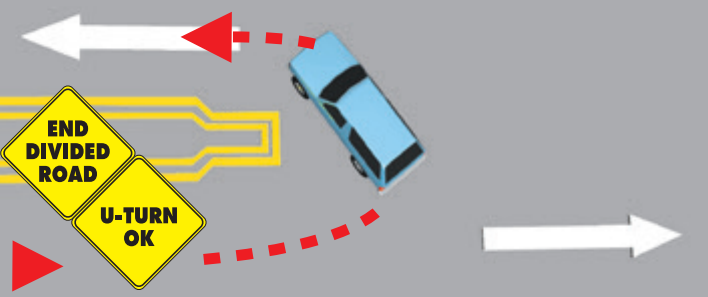
Broken yellow line
You may pass if the broken line is next to your driving lane, only pass when it is safe
Single solid white line
Traffic lanes going in the same direction (this includes one-way streets)
Double solid white lines
Indicate a lane barrier between regular use and preferential use (e.g. carpool HOV lane), also seen in or near freeway on and off ramps
NEVER change lanes over double solid white lines, wait till you see a single broken white line
Broken white lines
Separate traffic lanes on roads with 2+ lanes in the same direction
End of lane makrings
Large broken lines
If you are driving in a lane with these markings, be prepared to exit the freeway or for the lane to end
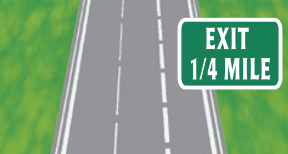
Yield line
A solid white line of triangles (pointing towards approaching vehicles) that shows where to yield or stop

Choosing a lane
Traffic lanes are often referred to by number, the left lane is number 1, the next one is 2, then 3, etc
Left lane —> use to pass or turn left, fast lane
Right lane —> enter or exit traffic

Changing lanes
Before you change lanes…
Signal
Check your mirrors
Check traffic behind and beside you
Look over your shoulder in the direction you plan to move to
Check your blind spots for vehicles, motorcyclists, and bicyclists
Be sure there is enough space for your vehicle in the next lane (it is not necessary to slow down before a lane change)
Types of lanes
Passing lane
Carpool / High-Occupancy Vehicle (HOV) lanes
Center left turn lanes
Turnout areas or lanes
Bicycle lanes
Passing lane
On a multilane road the passing lane is the one closest to the center divider (far left lane) and is used to pass other vehicles
Carpool / High-Occupancy Vehicle (HOV) lanes
To use, one of these must apply…
You have a certain number of people in your vehicle (there will be signs to tell you the minimum number of people and the hours HOV rules apply)
You are driving a low emission or zero emission vehicle (must display a special DMV-issued decal)
You are riding a motorcycle (unless otherwise posted)
Marked by a diamond symbol!
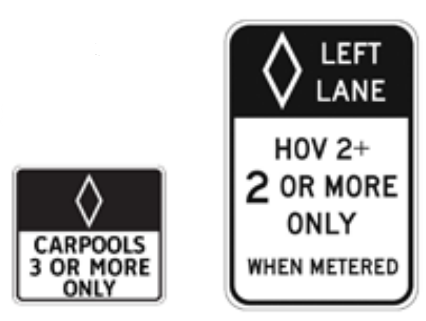
Center left turn lanes
Located in the middle of two-way street
Use to prepare for and make a left turn or U-turn
May drive for only 200 ft in the lane
To turn left from this lane…
Look for other vehicles coming toward you
Signal
Look over your shoulder to check blind spots
Merge completely into the center left turn lane as to not block traffic
Turn when it is safe
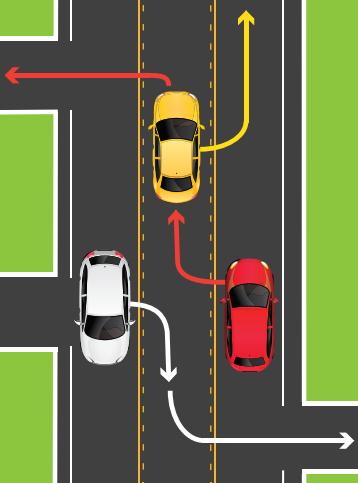
Turnout areas or lanes
Some two-lane roads have special turnout areas or lanes
Merge into these areas or lanes to allow cars behind you to pass, use when…
You are driving slowly on a two-lane road
Where passing is unsafe
There are 5+ vehicles following you
Bicycle lanes
Only for bicyclists, run alongside vehicle traffic, typically marked by a single solid white line and signs
Sometimes painted bright GREEN
They are illegal to drive in unless you are…
Parking (where permitted)
Entering or leaving the road
Turning (within 200 ft of an intersection)
Multiple types of bike lanes and markings
Bike lane
Buffered bike lane
Bike route
Bicycle boulevard
Separated bikeway
Shared roadway bicycle markings
Bike lane
Typically marked by a single solid white line that turns into a dash-line near an intersection
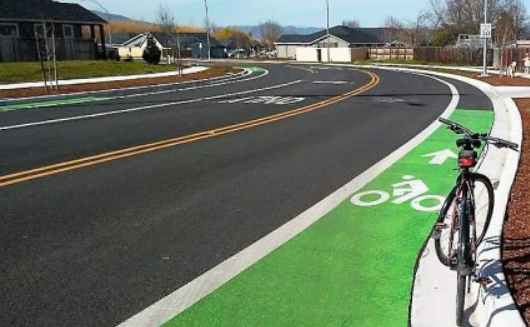
Buffered bike lane
Uses chevrons or diagonal markings to provide greater separation
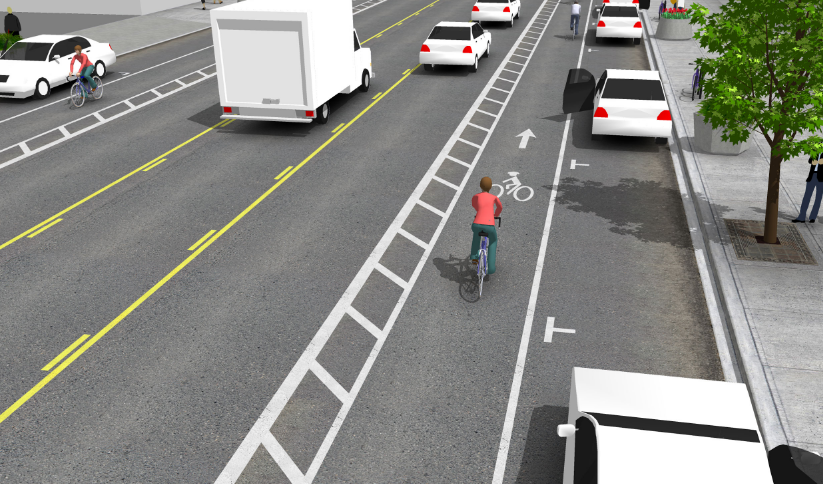
Bike route
Uses bike route signs and shared road markings to designate a preferred route for bicycles on streets shared with vehicle traffic

Bicycle boulevard
Prioritizes bicycle travel on streets shared with vehicle traffic
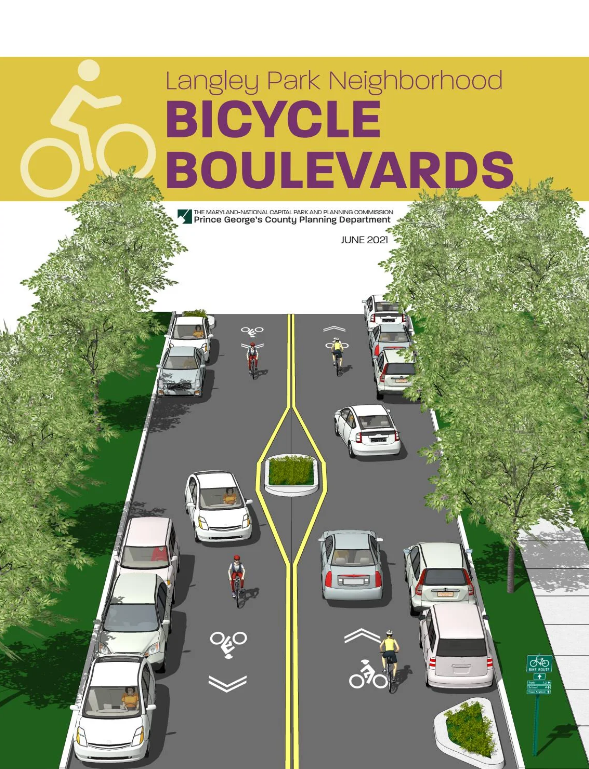
Separated bikeway
Is physically separated from motor vehicle traffic and is used exclusively for bicyclists
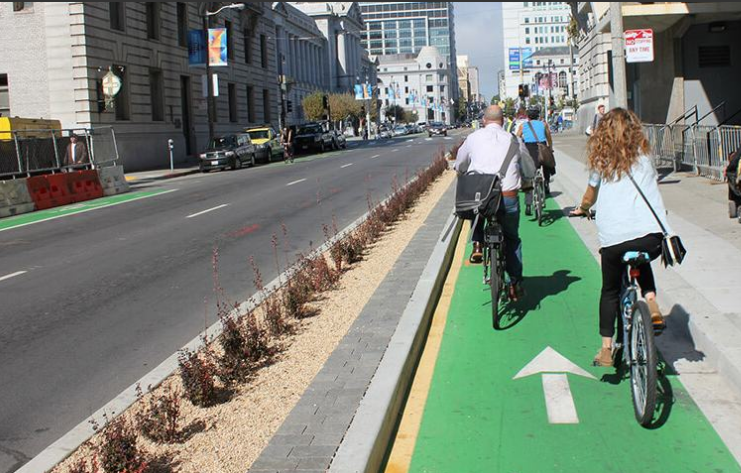
Shared roadway bicycle markings
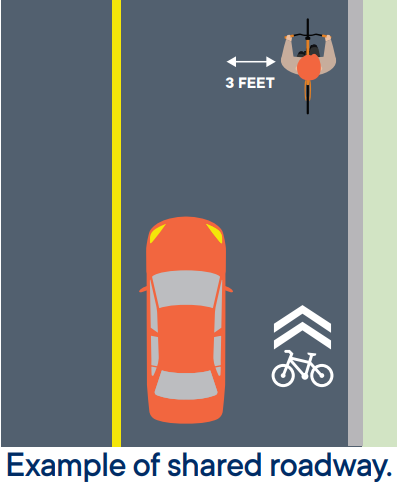
Normal right turn
Start signaling ~100 ft before the turn
Stop behind the limit line. If there is none, stop before the crosswalk. If there is none, stop before you enter the intersection.
Look both ways (left-right-left)
Begin and end the turn in the lane closest to the right edge of the road. Do not swing wide into another lane of traffic
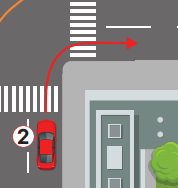
Right turn against a red light
You may turn right on red after a complete stop
UNLESS there is a “no turn on red” sign
Right turn at a public transit bus lane
You may cross a bus lane to make a right turn
It is illegal to drive, stop, or park in a designated public transit bus area
Right turn onto a road with a dedicated lane
A dedicated right turn lane does not merge into another lane and allows you to make the turn without stopping
You may make the turn even if there is a red light for vehicles going straight
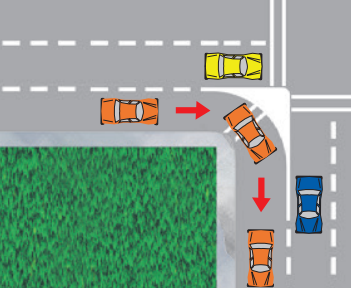
Normal left turn
Drive close to the center divider or into the left turn lane
DO NOT turn before the limit line!! (shown in image)
Keep your wheels pointed straight ahead until it is safe to start your turn. If your wheels are pointed to the left and a vehicle hits you from behind, you could be pushed into oncoming traffic
Enter the left turn lane within 200 feet of the turn
Signal 100 ft before the turn
Look both ways (left-right-left)
Left turn against a red light
Only permitted when turning from a one-way street onto another one-way street
You may make a U-turn…
Across a double yellow line
In a residential district if no vehicles are approaching within 200 ft
At an intersection on a green light (unless a “no u-turn” sign)
On a divided highway if a center divider opening is provided
Never make a U-turn…
Where a no u-turn sign is posted
At or on a railroad crossing
On a divided highway by crossing a dividing section, curb, strip of land, or two sets of double yellow lines
When you cannot see 200 ft in each direction
On a one-way street
In front of a fire station
In business districts
Turning at a “T” intersection from a one-way street onto a two-way street
Traffic going straight has the right-of-way
You may turn either right or left from the center lane
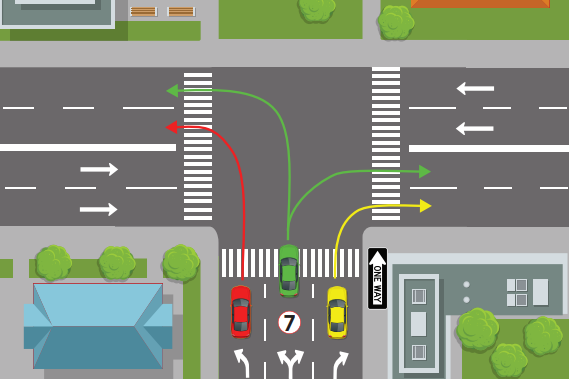
Braking
When stopping at a limit line, do not cross over the line
When stopping behind a vehicle, leave enough space to see their rear wheels
Merging into highway traffic / changing lanes
Be at or near the speed of traffic
Do not stop while merging unless absolutely necessary
Use your mirrors and turn signals
Turn your head quickly to look over your shoulder
Ensure you can stop safely by leaving 3 seconds of space between you and the vehicle in front of you
Do not cross over any solid lines
If you need to cross several lanes, signal and cross them one at a time
Exiting a highway
When in the proper lane, signal 5 seconds (~400 ft)
Make sure you are at a safe speed to exit
Do not cross over any solid lines
To merge, enter, or exit traffic, you need a space that is:
Half a block on city streets (~150 ft)
A full block on the highway (~300 ft)
You must judge whether you have enough space to pass whenever you approach…
An oncoming vehicle or bicyclist
A hill or curve (should be at least one-third of a mile ahead), intersection, or road obstruction
Do not pass when…
You are approaching a hill or curve and cannot see if other traffic is approaching
Within 100 ft of an intersection, bridge, tunnel, railroad crossing, or other hazardous areas
At crossroads and driveways
You don’t have enough space to return to your lane
How to pass
Signal that you plan on passing
Look over your shoulder to check your blind spots
Drive into the passing lane
Speed up to pass the vehicle
Signal and return to your original lane
NEVER drive off the paved or main-traveled part of the road to pass
You may pass on the right only when…
An open highway has two or more lanes going in your direction
The driver ahead of you is turning left (never pass on left when the driver is turning left!!!!!!)
You are on a one-way street
Being passed
Allow other vehicles to pass, maintain your lane position and your speed
Parallel Parking
When you park in line with the road and other parked vehicles
Find a space
Pull up alongside the vehicle in front of the space
Check your blind spots
Begin backing up
Straighten out
Park
To back up in a straight line…
Traffic check
Signal
Check your blind spots
Begin backing up
Control your vehicle
Parking on a hill
Downhill: turn the wheels toward the curb
Uphill: turn the wheels away from the curb
No curb: turn the wheels toward the shoulder of the road
Parking on a sloping driveway
Turn the wheels so the vehicle will not roll into the street
White curbs
Stop only long enough to pick up or drop off passengers
Green curbs
Park for a limited time (the time limit may be posted on signs or painted on the curb)
Yellow curbs
Load and unload passengers and freight
Do not stop longer than the time posted
When driving a noncommercial vehicle, you are usually required to stay with your vehicle
Red curbs
No stopping, standing, or parking
Buses may stop at a red zone marker for buses only
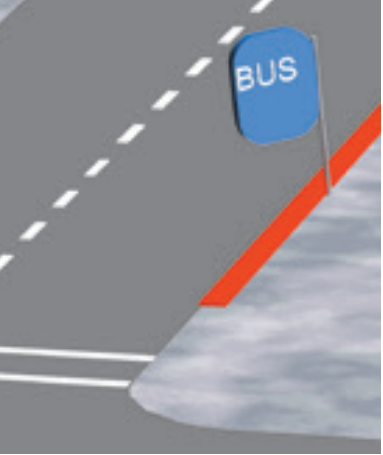
Blue curbs
Parking for a disabled person or someone driving a disabled person (must have a special placard or license plate)
Illegal Parking
where “no parking” sign is posted
on a marked or unmarked crosswalk
on a sidewalk
in front of a driveway
within 3 ft of a sidewalk ramp for disabled persons
in front of or on a curb that provides wheelchair access to a sidewalk
in the crosshatched area next to a designated disabled parking space
in a space designated for zero-emission vehicles
in a tunnel or on a bridge (unless permitted by signs)
within 15ft of a fire hydrant or fire station driveway
within 20ft of a crosswalk or within 15ft of a crosswalk where a curb extension is present
between a safety zone and curb
double parked
on the wrong side of the street or on a freeway (expect if an emergency)
If you must stop on a freeway…
park completely off the pavement
stay in your vehicle
keep your doors locked
Electric Vehicle sign

How do you drive green?
speed up and slow down smoothly
drive at a steady speed
regularly inflate your tires
get oil changes
check your filters
get rid of extra weight in your vehicle
During a law enforcement stop…
acknowledge that you see the officer by turning on your right turn signal
move completely onto the right shoulder
turn off your radio
remain inside your vehicle (unless officer directs you otherwise)
roll down your window after stopping your vehicle and before the officer makes contact with you
the driver and all passengers should place their hands in clear view
Your rights during an enforcement stop
if an officer asks your permission to do something, you have the right to say no
you must produce a driver’s license, proof of insurance, and vehicle registration
in California, only federal law enforcement officers can ask you about immigration status
you may record the interaction but make it clear that you are recording

Solid red light
means STOP
you may turn right at a red light if…
there is “no turn on red” sign
you stop first, yield for pedestrians, and turn when safe

Red arrow
STOP
don’t turn at a red arrow

Flashing red light
STOP, after stopping you may go when it’s safe

Solid yellow light
means CAUTION
when you see a yellow traffic light, stop
if you cannot stop safely, cautiously cross the intersection

Yellow arrow
Protected turning time is ending
the next light might be a green or red signal light or a red arrow

Flashing yellow light
PROCEED WITH CAUTION
slow down and be alert
you do not need to stop

Flashing yellow arrow
you can turn, but your turn is not protected from other traffic
turn left after yielding to oncoming traffic

Solid green light
means GO
you should still stop for any vehicle, bicyclist, or pedestrian in the intersection

Green arrow
GO in the direction the arrow is pointing
allows you to make a protected turn
Traffic light not working
Stop as if the intersection is controlled by STOP signs in all directions

STOP sign
Make a full stop at the limit line or before entering the crosswalk
if there is no limit line or crosswalk, than stop before entering the intersection
Check traffic in all directions before proceeding

Red YEILD Sign
Slow down and be ready to stop to let any vehicle, bicyclist, or pedestrian pass before you proceed

No U-turn

No left turn

No right turn

Slow moving vehicle

slippery when wet

merging traffic

divided highway

two way traffic

lane ends

end divided highway

traffic signal ahead

pedestrian crossing

added lane

crossroad

stop ahead